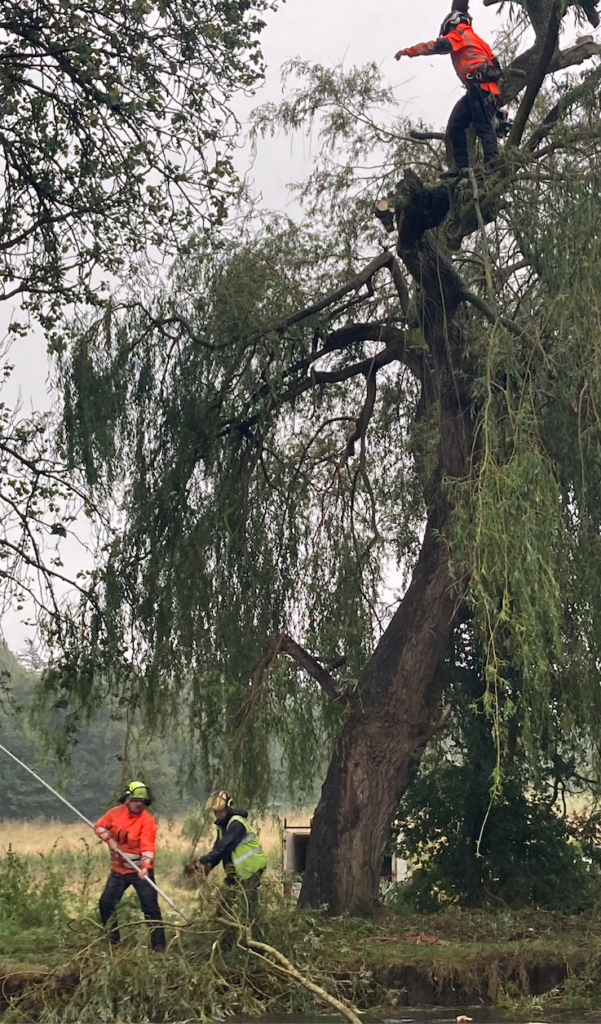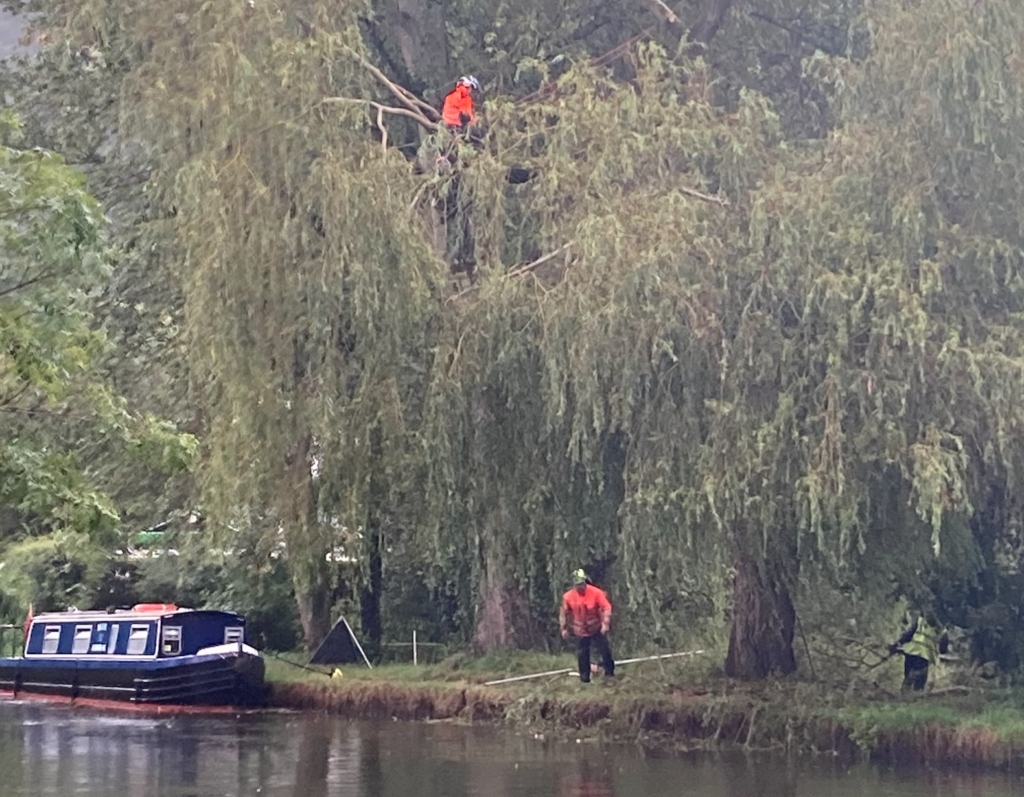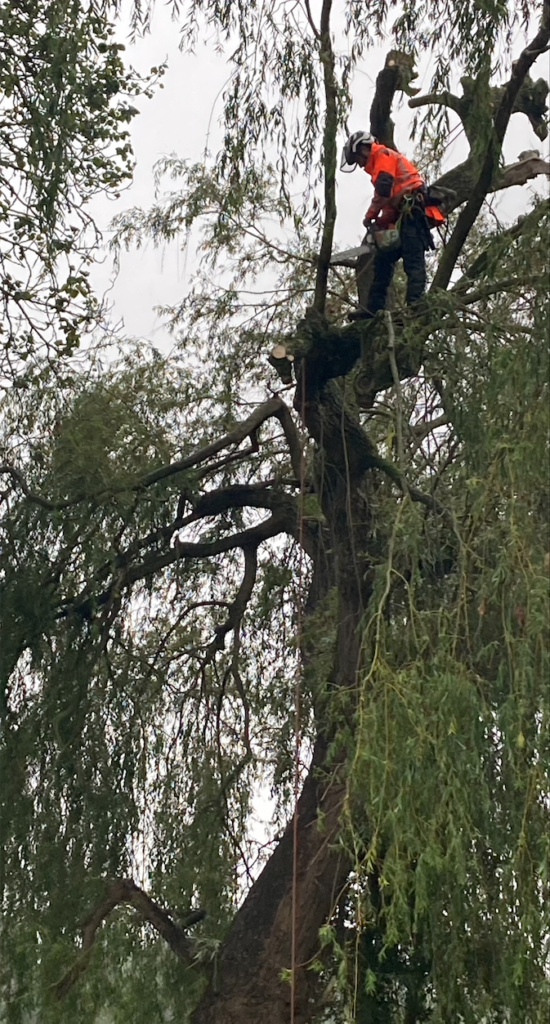 Abraham Lincoln
If given the truth, the people can be depended upon to meet any national crisis...
Abraham Lincoln
If given the truth, the people can be depended upon to meet any national crisis...
 Guildford news...
for Guildford people, brought to you by Guildford reporters - Guildford's own news service
Guildford news...
for Guildford people, brought to you by Guildford reporters - Guildford's own news service
Riverside Willows Receive Overdue Trim
Published on: 6 Sep, 2024
Updated on: 8 Sep, 2024
The weeping willows that give a picturesque frame to the River Wey by Shalford Meadow are being pollarded.
A GBC spokesperson said: “The trees are overdue re-pollarding and we have now started this process which will continue over the coming few years.
“The aim is to prune 10 trees this year, then 10 trees next year and then finish the remaining trees in the final third year.
“We will be staggering the 10 trees along the line of trees, not just working on 10 trees next to each other, so as to to spread the visual appearance of the works.”

Men below ensure the severed limb, attached to their pole, is brought safely to the ground. Photo Fiona Giles
According to Wikipedia, pollarding is a pruning system involving the removal of the upper branches of a tree, which promotes the growth of a dense head of foliage and branches. There are literary references to pollarding in Roman times.
The practice has occurred commonly in Europe since medieval times, and takes place today in urban areas worldwide, primarily to maintain trees at a determined height or to place new shoots out of the reach of grazing animals.
Traditionally, trees were pollarded for one of two reasons: for livestock fodder or for wood but pollarding tends to make trees live longer by maintaining them in a partially juvenile state and by reducing the weight and windage of the top part of the tree which might reduce the risk of collapse, especially during storms.
The willows at Shalford Meadow are believed to have stood on the bank for over 100 years, their roots helping to bind and strengthen the artificial bank beneath, much older than the trees, which constrains the River Wey into a deeper, narrower and since the 18th Century, navigable waterway.
It is also believed that managing the depth of the river was necessary in ancient times in order to provide sufficient headwater to power mills in the town, perhaps as early as the Saxon period.
Water sluices that used to be used to flood Shalford Meadow, noticeably at a lower level than the river, can still be seen but have not been operable for about 30 years. In the last century Shalford Meadow was used for skating when flood water froze as recently as the 1960s as the photo below shows.
Responses to Riverside Willows Receive Overdue Trim
Leave a Comment Cancel reply
Please see our comments policy. All comments are moderated and may take time to appear. Full names, or at least initial and surname, must be given.
Click on cartoon for Dragon story: Public Asked for Views on SCC’s Proposal for Reduced Speed Limits


Recent Articles
- Letter: Will GBC’s New Planning Document on Building Heights Be Effective?
- Proposed New Leisure Contract Should Improve Facilities and the Council’s Income
- Witness Appeal Following Fatal Collision
- Celebration at Guildford Cathedral of its Latest and Future Church Leaders
- Photo Feature: Now You See It…
- Letter: Snail-paced Progress for Full Weir Repair
- Mayor’s Diary: July 5 -July 20
- One Homeowner Recompensed but Fight Continues Over Waverley CIL Charges
- Letter: Fine Those Guilty of Anti Social Behaviour
- GBC Working Hard To Mitigate Looming Weyside Urban Village Deficit


Recent Comments
- Jan Messinger on Public Asked for Views on SCC’s Proposal for Reduced Speed Limits
- Fiona White on GBC Asks Residents for Views on Its Draft Building Height Guidance
- Dave Middleton on Letter: Fine Those Guilty of Anti Social Behaviour
- Carina Coverly on GBC Asks Residents for Views on Its Draft Building Height Guidance
- M Durant on Online Event Will ‘Help Residents Have Their Say On Local Government Reorganisation’
- Jim Allen on GBC Working Hard To Mitigate Looming Weyside Urban Village Deficit
Search in Site
Media Gallery
Dragon Interview: Local Artist Leaves Her Mark At One of England’s Most Historic Buildings
January 21, 2023 / No Comment / Read MoreDragon Interview: Lib Dem Planning Chair: ‘Current Policy Doesn’t Work for Local People’
January 19, 2023 / No Comment / Read MoreA3 Tunnel in Guildford ‘Necessary’ for New Homes, Says Guildford’s MP
January 10, 2023 / No Comment / Read More‘Madness’ for London Road Scheme to Go Ahead Against ‘Huge Opposition’, Says SCC Leader
January 6, 2023 / No Comment / Read MoreCouncillor’s Son Starts Campaign for More Consultation on North Street Plan
December 30, 2022 / No Comment / Read MoreCounty Council Climbs Down Over London Road Works – Further ‘Engagement’ Period Announced
December 14, 2022 / No Comment / Read MoreDragon Interview: GBC Reaction to the Government’s Expected Decision to Relax Housing Targets
December 7, 2022 / No Comment / Read MoreHow Can Our Town Centre Businesses Recover? Watch the Shop Front Debate
May 18, 2020 / No Comment / Read More









Aubrey Leahy
September 8, 2024 at 2:47 am
When flooded in my long ago youth, Station Meadows used to freeze over every year, especially in the cinder track area.
Great fun to ride though sheets of ice held up by chums. Would have said we had smashing times doing so but that pun considered too execrable for this publication…